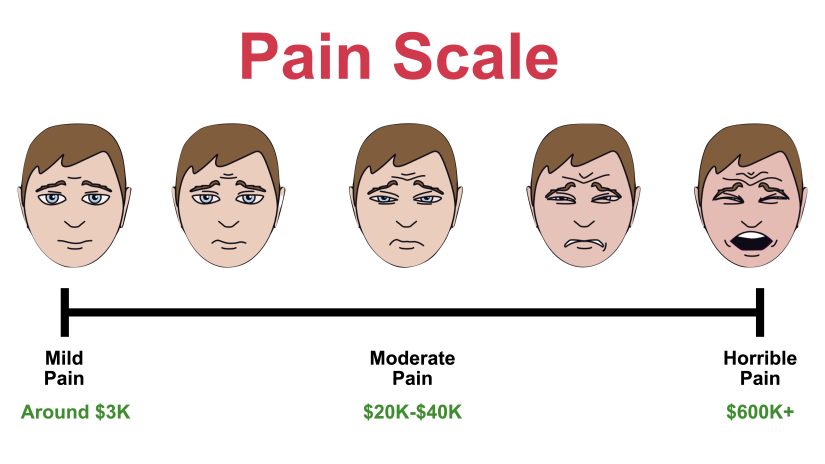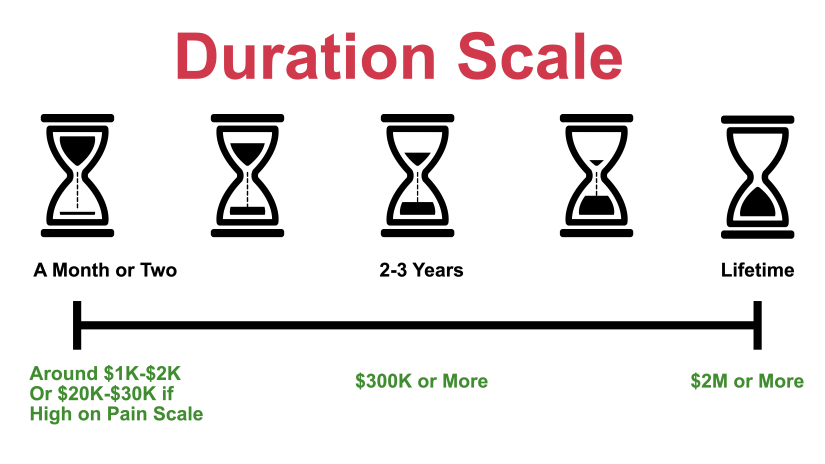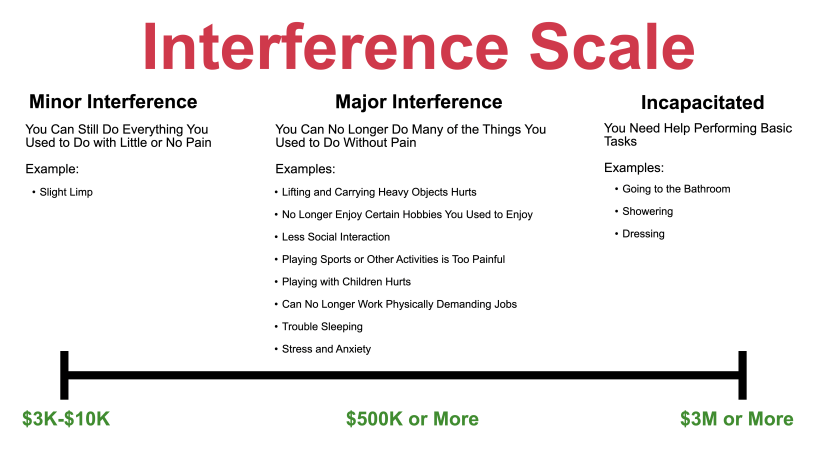How to Calculate Pain and Suffering in Your Car Accident Claim in Texas
December 1, 2023

When individuals in Texas face the aftermath of a car accident, the journey to recovery often encompasses more than just physical healing. In personal injury cases, financial compensation plays a pivotal role, particularly when it comes to non-economic damages, a category that captures the more intangible consequences of an accident. Among these, ‘pain and suffering’ stand out for their profound impact on a person’s life.
Pain and suffering, though intangible, are real and significant. They encompass not only the physical discomfort and agony one endures but also the emotional and psychological distress that follows. According to the Centers for Disease Control and Prevention (CDC), in 2020, the economic cost of motor vehicle crash injuries in the U.S. amounted to over $75 billion, which included both medical costs and lost productivity. However, this staggering figure barely scratches the surface of the full impact, as it doesn’t quantify the emotional and psychological toll on victims.
In Texas, the approach to quantifying these non-economic damages is both unique and critical. Assessing the extent of an individual’s pain and suffering can seem difficult for some. This guide aims to demystify the process, delving into the methodologies used in Texas to calculate these damages.
We will explore the Pain, Duration, and Interference (PDI) scales, a tool designed to provide a more objective measure of the subjective experience of pain and suffering. Understanding this process is vital for anyone involved in a personal injury case, ensuring that the full extent of their experience is recognized and justly compensated.
- Understanding Pain and Suffering Damages in Your Texas Car Accident Case
- Overview of the Pain, Duration, and Interference Scales
- Other Methods for Calculating Pain and Suffering Damages in Texas
- The Anchoring Effect in Jury Calculations for Pain and Suffering Damages
- Jury Selection Strategies in Texas Personal Injury Cases
- Calculating Total Non-Economic Damages
- Conclusion
Understanding Pain and Suffering Damages in Your Texas Car Accident Case
Non-economic damages in personal injury law refer to the losses that are intangible and not directly quantifiable in monetary terms. These include:
- physical pain and mental suffering,
- emotional distress,
- loss of enjoyment of life, and
- loss of companionship or consortium.
Unlike economic damages, such as medical bills or lost wages, which have a clear financial value, non-economic damages are subjective and vary greatly from case to case.
Pain and suffering, a major component of non-economic damages, encompasses the physical pain and mental suffering a person endures as a result of their injury. This can range from the immediate physical discomfort to long-term chronic pain, and includes the psychological impact, such as depression, anxiety, and trauma. The American Psychological Association highlights the intertwined nature of physical and psychological pain, noting that chronic pain can lead to significant psychological distress and vice versa.
The loss of enjoyment of life, another key aspect, refers to the diminished quality of life due to the injuries. This might include an individual’s loss of the desire to participate in hobbies, sports, or other activities that they previously enjoyed. It reflects the impact of the injury on the person’s overall lifestyle and happiness.
In Texas, as in many states, the assessment of these damages requires a nuanced approach. There’s no exact science or formula to calculate them. Instead, juries and courts often rely on a combination of factors, including the severity and permanence of the injury, the impact on daily life, and the pain and suffering endured.
The Texas Supreme Court has consistently upheld the subjective nature of these damages, recognizing the importance of jury discretion in determining fair compensation based on the evidence presented.
Understanding non-economic damages is crucial for anyone involved in a personal injury case in Texas. It ensures a holistic view of the injury’s impact, going beyond the immediate financial costs to consider the deeper, more personal toll of the accident.
Overview of the Pain, Duration, and Interference Scales
The Pain, Duration, and Interference (PDI) scales provide a structured approach to evaluating non-economic damages in personal-injury cases, particularly in Texas. This methodology offers a more objective lens through which the subjective experiences of pain and suffering can be assessed and quantified for legal purposes.
- Pain Scale: This scale measures the intensity of the victim’s physical pain. It ranges from mild discomfort to severe, debilitating pain. The evaluation considers not just the severity, but also the type of pain—whether it’s sharp, dull, constant, or intermittent. This scale is crucial because the level of physical pain can significantly affect a person’s quality of life and daily functioning.
- Duration Scale: This aspect assesses how long the pain and suffering have lasted and are expected to last. Duration can vary from temporary, lasting only a few days or weeks, to chronic or permanent conditions that may persist for years or a lifetime. The length of time a person is expected to endure their pain plays a significant role in determining the compensation.
- Interference Scale: This scale evaluates the extent to which the injuries have impacted the victim’s daily life. It considers factors like the ability to perform work-related tasks, engage in social activities, and complete everyday chores and activities. The more an injury interferes with these aspects of life, the higher the potential compensation might be.
By using the PDI scales, attorneys and juries in Texas can break down the complex and subjective nature of pain and suffering into more quantifiable elements. This approach facilitates a fairer and more accurate determination of non-economic damages, ensuring that victims are adequately compensated for the full extent of their suffering.
Step 1: The Pain Scale
The Pain Scale in the PDI (Pain, Duration, and Interference) methodology is a critical component in assessing non-economic damages in personal injury cases. This scale is designed to quantify the severity of the victim’s physical pain following an accident or injury. Its importance lies in the fact that physical pain, often the most immediate and apparent consequence of an injury, can profoundly impact a person’s life and well-being.

1. Understanding the Pain Scale: The Pain Scale ranges from mild to excruciating. Mild pain might be a discomfort that is noticeable but does not significantly disrupt one’s daily activities.
Moderate pain, on the other hand, is more intense and can hinder some activities. Severe pain is debilitating, preventing a person from performing their normal routine.
The highest level, excruciating pain, is all-consuming and unbearable, often requiring continuous medical management.
2. Examples of Pain Levels and Compensation:
- Mild Pain: For instance, if an individual experiences minor whiplash from a rear-end collision, resulting in mild neck pain that subsides with minimal treatment, the compensation might be relatively low. This level of pain, while uncomfortable, does not significantly impact the person’s quality of life.
- Moderate Pain: Consider a broken arm from a fall caused by a slippery floor. The pain is more intense and might impede daily tasks like driving or typing. In such cases, the compensation could be higher to account for the inconvenience and lifestyle adjustments required during the healing process.
- Severe Pain: Severe pain cases might involve injuries like herniated discs or complex fractures, where the pain is constant and significantly disrupts daily life, including work and leisure activities. Compensation in these instances could be substantial, reflecting the major impact on the person’s quality of life.
- Excruciating Pain: An example of excruciating pain could be a severe burn injury or spinal cord damage leading to chronic, intense pain. Such cases often involve ongoing medical treatment, possibly including surgeries, physical therapy, and long-term pain management. The compensation awarded in these scenarios would likely be significant, considering the immense and enduring impact on the individual’s life.
3. Factors Influencing Pain Scale Assessment: The assessment of pain is not just about the intensity; it also considers the nature of the pain (sharp, throbbing, burning, etc.), its consistency (constant or intermittent), and how it responds to treatment. Furthermore, the individual’s personal pain threshold and ability to cope with pain are considered, as these can vary significantly from person to person.
The Pain Scale in the PDI framework is a tool that enables a more objective evaluation of the subjective experience of pain. It aids in ensuring that the compensation awarded in personal injury cases is commensurate with the severity of the pain endured, thus contributing to a fairer outcome for the injured party.
Step 2: The Duration Scale
The Duration Scale in the PDI methodology is integral to understanding the full impact of an injury in personal injury cases. This scale assesses the length of time the victim experiences pain and suffering, which is crucial in determining appropriate compensation. The duration of pain, whether short-term or chronic, significantly affects the victim’s life and is a key factor in legal evaluations.

1. Short-Term Pain: Short-term pain is typically associated with injuries that heal within a few days to a few months. For example, minor soft tissue injuries or simple fractures usually fall into this category. While the pain can be intense, its temporary nature means a relatively quicker return to normalcy. In such cases, compensation might be calculated to cover the period of discomfort and disruption but is generally lower than for long-term pain.
2. Long-Term and Chronic Pain: Long-term pain, lasting several months to years, and chronic pain, which may persist indefinitely, represent a more serious impact on a person’s life. Injuries resulting in long-term or chronic pain could include serious joint injuries, nerve damage, or conditions that develop post-accident, like chronic pain syndrome. Here, compensation needs to account not only for the current suffering but also for the ongoing and future impact on the victim’s life.
3. Factors Influencing Duration Assessment: When assessing the duration of pain, several factors are taken into account. These include the nature of the injury, the expected recovery time based on medical prognosis, and the actual experience of the victim. Medical records and expert testimonies often play a significant role in establishing the expected duration of pain.
4. Impact of Duration on Compensation: The longer the pain lasts, the higher the potential compensation. For instance, a person who suffers from chronic back pain due to an accident might be unable to engage in certain activities for the rest of their life. This not only affects their quality of life but may also lead to other complications, such as mental health issues or secondary physical problems, thereby justifying a higher compensation amount.
Understanding the duration of pain is essential in personal injury cases as it directly correlates to the extent of the victim’s suffering and their long-term prognosis. Accurately assessing this duration ensures that the compensation awarded reflects the true impact of the injury on the victim’s life, both currently and in the future.
Step 3: The Interference Scale
The Interference Scale is the third critical component of the PDI (Pain, Duration, and Interference) methodology used in evaluating non-economic damages in Texas personal injury cases. This scale measures the extent to which the injury disrupts the victim’s daily life, including their ability to work, engage in social and recreational activities, and perform routine tasks. The degree of interference directly influences the amount of compensation awarded.

1. Minor Interference: At the lower end of the scale, an injury may cause some discomfort or minor restrictions, but the individual can still largely maintain their normal lifestyle. For example, a person with a minor hand injury may experience some difficulty in certain tasks but can still manage most of their daily activities without significant alteration. In such cases, the compensation for pain and suffering might be relatively modest, acknowledging the inconvenience without indicating a major life disruption.
2. Major Interference: Injuries causing moderate to significant interference dramatically alter the victim’s ability to function normally. This might include injuries that prevent the person from performing their job, engaging in hobbies or sports they previously enjoyed, or participating fully in family life. For instance, a severe knee injury that stops someone from continuing a physically demanding job or playing a favorite sport would be considered significantly interfering. Compensation in such cases is generally higher, reflecting the substantial impact on the individual’s quality of life.
3. Incapacitated: The highest level of interference is where an injury profoundly affects nearly all aspects of the victim’s life. This might include spinal injuries leading to paralysis, severe brain injuries, or other conditions that render the person dependent on others for basic care.
In these situations, the compensation is typically substantial, aiming to address the profound changes in the person’s lifestyle, autonomy, and overall well-being.
4. Factors Affecting Interference Assessment: The evaluation of interference considers the victim’s pre-injury lifestyle, their post-injury capabilities, and the extent of adjustments required to accommodate the injury. Personal testimony, medical records, and expert opinions are often pivotal in illustrating the injury’s impact on the individual’s life.
The Interference Scale is crucial in quantifying the impact of an injury on a person’s day-to-day life. By accurately assessing the level of interference, the compensation awarded can more appropriately reflect the extent to which the injury has altered the victim’s life and overall happiness.
Other Methods for Calculating Pain and Suffering Damages in Texas
In addition to the PDI Scales, there are other methods commonly used in Texas to calculate pain and suffering damages in personal injury cases. These alternative methods provide different approaches to quantify the intangible losses suffered by victims.
Multiplier Method
One widely used approach is the multiplier method. This involves taking the total amount of economic damages, such as medical bills and lost wages, and multiplying it by a certain number (the multiplier) to calculate pain and suffering damages. The multiplier typically ranges from 1.5 to 5 and is selected based on factors like the severity of the injury, the recovery time, and the impact on the victim’s life. For instance, a person with minor injuries and a quick recovery might have their economic damages multiplied by a lower number, whereas someone with severe, long-lasting injuries might warrant a higher multiplier.
Per Diem Method
Another method is the per diem approach, which assigns a daily rate for pain and suffering, similar to a daily wage. This rate is then multiplied by the number of days the victim is expected to experience pain and suffering. For example, if a certain amount is determined as a reasonable daily rate for the victim’s pain and suffering, and they suffer for 100 days, the total non-economic damages would be 100 times that daily rate. This method attempts to quantify the day-to-day hardship endured by the victim.
Comparative Analysis
Sometimes, attorneys and courts look at past cases with similar injuries and circumstances to gauge an appropriate amount for pain and suffering. This method involves reviewing settlements and jury awards in cases that had comparable levels of injury and impact on the victim’s life.
Each of these methods has its own advantages and limitations. The multiplier method is straightforward but can be arbitrary, as the selection of the multiplier is subjective. The per diem approach offers a more granular view but may not fully account for long-term or fluctuating pain levels. Comparative analysis provides context but may not always accurately reflect the unique aspects of the current case.
In Texas, the choice of method depends on the specifics of the case, the available evidence, and often, the legal strategy employed. Understanding these different approaches is essential for lawyers and their clients to effectively argue for fair compensation in personal injury cases.
The Anchoring Effect in Jury Calculations for Pain and Suffering Damages
The concept of anchoring plays a significant role in jury decisions regarding pain and suffering damages in personal injury lawsuits. Anchoring is a cognitive bias where individuals rely too heavily on the first piece of information (the “anchor”) when making decisions. In the context of personal injury lawsuits, the jury often uses the dollar amount of total medical expenses, a concrete and easily calculable figure, as this anchor. This can inadvertently lead to undervaluing the plaintiff’s pain and suffering damages, which are more abstract and do not have a market-based value.
1. Impact of Medical Bills as Anchors:
- When juries are presented with medical bills, they often use these figures as a starting point to determine pain and suffering damages.
- This anchoring to a tangible amount frequently results in pain and suffering awards that do not fully reflect the true extent of the plaintiff’s suffering, as these damages are more subjective and less quantifiable.
2. Strategic Response by Plaintiff’s Lawyers:
- To counteract this tendency, plaintiff’s lawyers in Texas are increasingly opting not to claim damages for medical bills in their lawsuits, focusing solely on pain and suffering damages.
- This approach allows lawyers to set their own, often much higher, anchor for damages, shifting the jury’s focus entirely to the pain and suffering aspect.
3. Setting a High Anchor for Pain and Suffering:
- By avoiding detailed discussions on medical bills and their reasonableness, which can be tedious and distract from the main issue, lawyers can keep the jury’s attention on the pain and suffering narrative.
- The high anchor set by the plaintiff’s lawyer for pain and suffering is typically much greater than the actual medical costs, aiming to maximize the compensation.
4. Jury’s Response to the High Anchor:
- Although juries often discount the high figures proposed by plaintiff’s lawyers, the anchoring effect generally ensures that the discounted amount still exceeds the total medical expenses, often by a significant margin.
- This strategy leverages the psychological tendency of anchoring to ensure a more favorable outcome for the plaintiff, even after the jury’s adjustment.
5. Risks Involved:
- Credibility Concerns: Not claiming medical bills might raise questions about the validity of the pain and suffering claims, potentially undermining the plaintiff’s credibility.
- Unpredictability of Jury Decisions: Without medical bills as a guide, jury awards can become more unpredictable, which could work for or against the plaintiff.
- Risk Analysis: The decision to adopt this approach requires careful consideration of the case specifics, the client’s circumstances, and an assessment of potential jury reactions. It’s a balance between maximizing potential damages for pain and suffering and maintaining the credibility and persuasiveness of the claim.
In conclusion, understanding and strategically utilizing the anchoring effect in jury award calculations can be a powerful tool in personal injury lawsuits. By focusing solely on pain and suffering damages and setting a high anchor, plaintiff’s lawyers can effectively influence jury awards to more accurately reflect the true extent of the plaintiff’s suffering.
Jury Selection Strategies in Texas Personal Injury Cases
In Texas personal injury cases, jury selection is a critical process, especially considering that many potential jurors may hold biases against awarding damages for pain and suffering. The common rationale among these jurors often goes along the lines of, “I have pain and suffering but I just deal with it, you don’t see me asking for money for it.” To address this challenge, lawyers employ strategic jury selection methods during voir dire to identify and potentially exclude jurors with such beliefs.
1. Voir Dire and Identifying Biases: Voir dire, the jury selection process, provides attorneys the opportunity to ask potential jurors questions that reveal their attitudes and beliefs about pain and suffering damages. The goal is to uncover any biases that may affect their ability to impartially consider the evidence and the law.
2. Example Questions to Reveal Biases:
- Attorneys might ask questions like, “Do you believe that someone should be compensated for pain and suffering following an accident?” This straightforward question can reveal if the juror has a fundamental objection to the concept of non-economic damages.
- Another question could be, “Can you think of a situation where you believe it would be appropriate for someone to receive money for pain and suffering?” This allows the attorney to gauge the juror’s flexibility in their thinking about non-economic damages.
- Lawyers might also ask, “Have you or someone close to you ever been involved in a situation where you had to deal with pain without seeking compensation?” This personalizes the issue and can uncover any personal experiences that might color the juror’s judgment.
3. Removing Jurors for Cause: When jurors express strong biases against pain and suffering damages, attorneys can challenge them for cause, arguing that these jurors cannot be impartial. The judge then decides whether to excuse these jurors based on their expressed biases.
4. The Importance of Jury Selection: Effective jury selection is crucial in personal injury cases. It ensures a fair trial by creating a jury that can objectively assess the case’s merits, including the legitimacy and extent of pain and suffering claims.
By carefully navigating the jury selection process, attorneys can better position their cases for a fair hearing, significantly impacting the outcome of personal injury litigation in Texas.
Calculating Total Non-Economic Damages
The process of calculating total non-economic damages in Texas personal injury cases is a complex and nuanced task. It involves the integration of assessments from the Pain, Duration, and Interference (PDI) Scales, along with considering other methodologies like the multiplier method or per diem approach. Each element – pain, duration, and interference – contributes to a comprehensive picture of the victim’s suffering and loss of quality of life.
Legal professionals must carefully weigh the evidence and testimonies presented to accurately determine the extent of non-economic damages. This includes considering the intensity and longevity of pain, the degree to which the injury has disrupted the victim’s daily life, and any other psychological or emotional impacts. The final calculation is meant to reflect a fair and just compensation, recognizing the invisible yet profound effects of the injury on the victim’s life.
In sum, the goal is to ensure that the awarded damages adequately compensate for the full scope of the victim’s pain and suffering, providing a measure of relief and recognition of their ordeal.
Conclusion
Understanding the intricacies of calculating pain and suffering in Texas personal injury cases is essential for achieving fair compensation. The use of the PDI Scales, along with other methods like the multiplier and per diem approaches, provides a framework for quantifying these non-economic damages. The strategic considerations in presenting cases, coupled with the critical process of jury selection, further underscore the complexity of these legal proceedings. Victims and their legal representatives must navigate these aspects with diligence and insight. Ultimately, a comprehensive and empathetic approach towards evaluating pain and suffering ensures that justice is not only served but also felt by those who have endured loss and hardship.